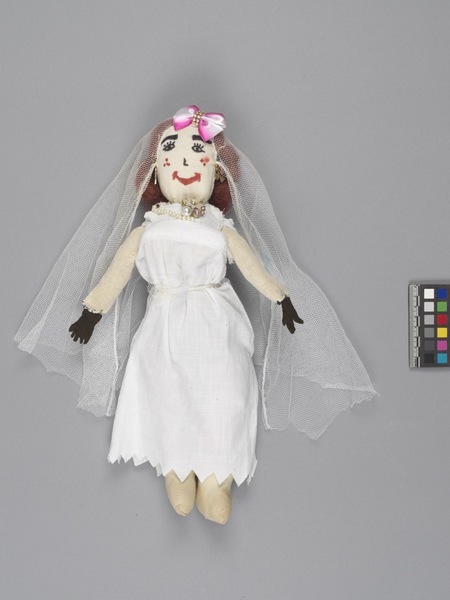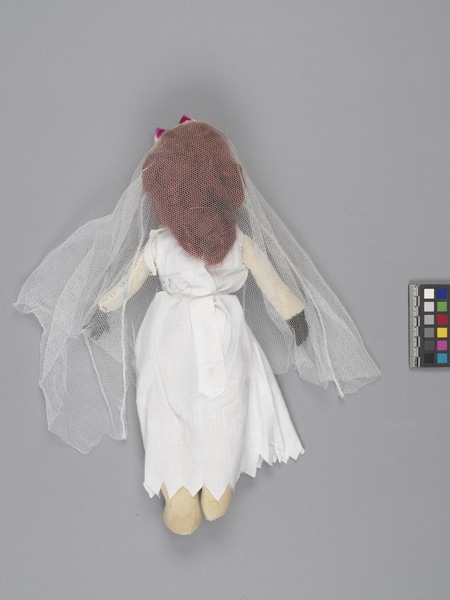Hand Puppet Item Number: 3381/28 from the MOA: University of British Columbia


Description
Calungo hand puppet of a 'Noiva (bride) Benedita' character (the form is more similar to a doll than a puppet). The fabric body is off-white with attached black glove-like hands. Her facial features are drawn in felt with almond-shaped black eyes, thick eyebrows, small nose, smiling burgundy mouth and rosy cheeks. She wears a long white sleeveless dress. Her red-brown hair is tied up, and worn under a white veil with a large jewelled pink and white bow. She wears earrings and a necklace.
History Of Use
The puppet represents a character from a form of popular puppet theatre, found in northeastern Brazil, called mamulengo. This type of theatre is prevalent in disenfranchised communities with ancestral ties to colonized Indigenous peoples and uprooted, enslaved Africans. Mamulengo performances are entertaining events that can last all night long, with puppeteers (mamulengueiros) using 70 to 100 puppets in one staging. The stages are pop-up stands (empanadas), made of brightly coloured, floral-printed cloth. The shows consist of short sequences (passagens), or skits from popular stories that expose the inequalities and dramas of everyday life, profiling stock characters such as rich landowners and peasant labourers. The whole is spun together with humour, satire, lively music, and audience commentary.
Item History
- Made by Marcos Araujo (Maker) in Icapui, Ceara, Brazil during 2018
- Owned by Associacao Cultural de Amigos do Museu de Folclore Edison Carneiro before July 25, 2019
- Received from Associacao Cultural de Amigos do Museu de Folclore Edison Carneiro (Seller) and Museum of Anthropology Exhibitions Budget (Funding source) on July 25, 2019
What
Who
- Culture
- Brazilian
- Creator
- Marcos Araujo (Maker)
- Previous Owner
- Associacao Cultural de Amigos do Museu de Folclore Edison Carneiro
- Received from
- Associacao Cultural de Amigos do Museu de Folclore Edison Carneiro (Seller) and Museum of Anthropology Exhibitions Budget (Funding source)
Where
- Holding Institution
- MOA: University of British Columbia
- Made in
- Icapui, Ceara, Brazil
When
- Creation Date
- during 2018
- Ownership Date
- before July 25, 2019
- Acquisition Date
- on July 25, 2019
Other
- Condition
- good
- Accession Number
- 3381/0028